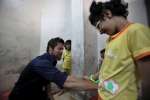Asylum-seekers await application results at historic Berlin airport
News Stories, 17 November 2015
BERLIN, Germany, Nov 17 (UNHCR) – Their journeys now over, thousands of asylum-seekers are awaiting the results of their applications in a cavernous, historic airport in the German capital, Berlin. With freezing temperatures approaching fast, German authorities are scrambling to ensure no one is left out in the cold.
"I headed for Germany because a lot of my relatives are here already," said Ibrahim, 21, who weeks earlier fled fighting near his home in Idlib, north-western Syria together with his 19-year-old wife Nour and their one-year-old son, Ahmed.
Now, their perilous 3,000-km journey over land and sea behind them, the young family has little to do but wait. Last week they joined thousands of asylum-seekers housed in the hangars of Berlin Tempelhof Airport, an imposing, monumental construction designed and built in the 1930s.
"I can't imagine what will happen in the future when I get out of here. But, god willing, I will find work," said Ibrahim, who used to run an internet café in Syria. "It's OK here, but it's very hard if I compare it to a different time before all of this."
Germany has seen unprecedented numbers of asylum-seekers entering the country in recent month. According to Government statistics, some 760.000 asylum requests have been recorded in Germany in 2015 so far.
Berlin, like other German cities, is struggling to house hundreds of new arrivals every day. More than 40,000 asylum-seekers have been registered in the capital alone this year and most emergency shelters in schools and sports halls are already full.
In October, the city turned to the former American airbase at Tempelhof Airport, a gigantic structure also famous for its use by the Western Allies in the Berlin airlift during the Cold War. The building, which covers 300,000 square metres, is now one of the remaining large-scale solutions to house new arrivals over the harsh winter.
Over the past weeks its population has been growing steadily. The airport is now home to more than 2,000 asylum-seekers, among them 500 children. Last week Berlin said it would open up more parts of the terminal in a bid to house a further 4,000 people.
"We're building a city here," said Maria Kipp, Public Relations Officer at Tamaja, the service provider contracted by Berlin city authorities to run the camp. "We had about a weekend to set it all up, together with the army, so we're building the infrastructure as we go along."
"Then there's the problems you just get with so many people living in three big halls. There's definitely room for improvement," she added. "We're looking forward to Save the Children setting up children's activity rooms in each of the hangars soon. It's very difficult to keep all the kids occupied."
Syrian mother-of-three Zayna, 30, knows the problem well.
"It's OK here, but it's hard with the children," she said, her 3-year-old son Mohammed wriggling in her arms as her daughter Bana, 6, swings and clutches at her skirt. Her eldest son Yamin, 7, is nowhere to be seen – off playing somewhere in the hangar.
Zayna's children are visibly restless, waiting to be reunited with their father, who left the family home in war-torn Aleppo for Germany four months ago. "I headed for Germany because my husband was already here," said Zayna. "He said it would be OK. But I don't know where he is now, I hope I'll find him. We're just waiting now, we have no idea how long we'll be here."
The Tempelhof solution, which the city insists is a temporary one, is far from ideal. Toilets are the portable kind outside, and there are no taps or showers on site. The camp's operation still owes much to volunteers. In a back room, they sort through piles of donated clothing. Next door, volunteer chefs prepare small plastic dishes of olives and hummus and freshly-baked bread for the evening meal.
Alongside the new children's rooms, Kipp said the operators are planning a separate prayer room. But despite the hangar's lofty expanses, private space is extremely limited. Ibrahim, Nour and Ahmed share a cabin – made from temporary dividers of the kind used in trade fairs – with eight others.
"We just have to be patient with the other family we are sharing with," said Ibrahim. "We're all in there together so we just have to be tolerant."
Josie Le Blond, Berlin, Germany














































